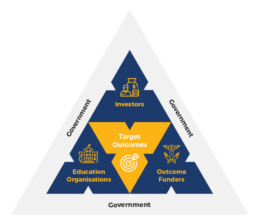Over 10 million youth are trained annually through various government skilling schemes that fund short-term programs at zero cost to the youth, with govt. reimbursing the Training Partners (TPs)
What is the Challenge?
This supply-led (rather than demand-led) model has attracted many TPs to these schemes, however, the tight budgets often lead to a tendency to underinvest per beneficiary, resulting in low placements and poor income/career progression for the end beneficiaries.
Designing the Solution
This supply-led (rather than demand-led) model has attracted many TPs to these schemes, however, the tight budgets often lead to a tendency to underinvest per beneficiary, resulting in low placements and poor income/career progression for the end beneficiaries.
How Would it Work?
- The fund would provide incremental funding to select high-quality Training Partners for delivering demand-led short-duration skilling courses.
- Training Partners would leverage funding available through schemes such as PMKVY ($200-350 per youth) and use the incremental funding for strengthening processes such as employer engagement, post-placement support, mentoring etc. with the aim of improving return on investment for trainees, employers as well as government.
The Rationale for an Outcome Fund Structure
Investing more per beneficiary upfront can lead to a lower cost per outcome eventually. Evidence from many skilling and employability programs, globally and in India, suggests that providing incremental funding to high-quality interventions to strengthen their delivery models and processes can result in better outcomes in terms of higher placements, income, and longer job retention.
Function and Value Proposition
of an Outcomes Fund
- Outcomes Fund is a powerful new set of partnerships and a new way of financing social projects by leveraging private capital to transfer / underwrite performance risk.
- Delivers greater value-for-money on a per-outcome basis, even if that means potentially increasing the per-beneficiary costs to increase the targeted end outcomes.
- Rather than fragmented spending by multitude of funders, it pools donor funding to drive large-scale, coherent improvement by aligning multiple stakeholders to a common, agreed set of outcomes.
- Rather than funding service providers for inputs and activities, it strongly incentivizes them to be demand-led (driven by the needs of employers) and only rewards for the independently verified results such as job placements and retention.
- Creates transparency around the cost-per-outcome of different interventions, which can ensure that government policy makers and the broader donor community can systematically shift funds towards scaling programs that demonstrate the best results and value for money.
- Empowers and supports Service providers to innovate, adapt, and find context-specific solutions.

